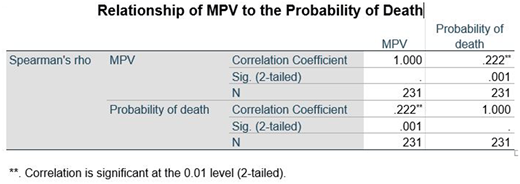Abstract
Background: Sickle cell disease (SCD) is a life-threatening disease with varied clinical spectrum and severity leading to premature death. There is a lack of validated prognostic markers in SCD. Recent evidence suggests that inflammation and platelet adhesion plays a critical role in the pathophysiology of vaso-occlusion in SCD. Elevated Mean Platelet Volume (MPV) values are associated with a higher degree of inflammation in many disease states but its effect on sickle cell disease or its severity is unknown.
Objective: To analyze the role of MPV in predicting disease severity/mortality in patients with SCD.
Methodology: This is a retrospective single center study and included patients with sickle cell disease between 6 months and 60 years of age during a 10-year period (2006-2016). Demographic information, lab data and clinical information including acute chest syndrome (ACS), priapism, transfusions, sepsis, pain crisis, avascular necrosis (AVN) were collected. All laboratory data were collected in steady state with no crisis in the recent past 3 months. The disease severity score/probability of death was calculated using a validated model to predict risk of death in sickle cell disease (Sebastiani et al. Blood 2007). Spearman's correlation test was used to analyze correlation coefficient between MPV and probability of death.
Results: Total no. of patients =230; Male 112 (49%); Female 118 (51%). All patients were of African-American origin. Disease severity, Hb SS - 156 (67.5%); Hb SC - 64 (27.8%) and Sickle-Beta thalassemia 11 (4.7%). MPV has a significant positive correlation with the probability of death, p < 0.001 and correlation coefficient, r=0.222. Of the total population, 78 had acute chest syndrome, 30 had AVN, 47 had recurrent pain crisis, 16 had stroke (2 -moyamoya cases), 18 had culture proven sepsis. Our population was further divided into 3 subgroups based on their age (Group 1 - 0-18 years; Group 2 - 19-40 years; group 3- above 40 years) and we found no statistical difference in the mean platelet volume across different age groups. However in pediatric population (Group 1), hydroxyurea was associated with significantly lower MPV, p=0.023 and this is independent of Hb F levels. Using linear regression model, with probability of death as a dependent variable and hydroxyurea, MPV as independent variables, MPV maintains a significant association with probability of death (p=0.003). We also found strong positive correlation of MPV with the probability of death in pediatric age group, p=0.004, r =0.405.
Conclusion:
MPV is an independent biomarker predicting disease severity and probability of death in patients with sickle cell disease with a strong correlation especially in pediatric age group. Although there was no statistical significance across age groups, the variation of MPV for each patient with age needs to be studied for better understanding. Hydroxyurea a known disease-ameliorating agent is associated with lower MPV values in pediatric age group. This effect is independent of the levels of fetal hemoglobin and may be due to anti-inflammatory effect of hydroxyurea or decreased platelet consumption.
No relevant conflicts of interest to declare.
Author notes
Asterisk with author names denotes non-ASH members.


